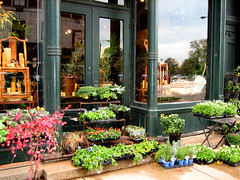The retail you want vs. the retail the market can support
(Flower shop storefront with plants in the Old Town area of Chicago, Illinois. Uploaded by Atelier Teee.
With no apologies to Donald Rumsfield...
1. This is about revitalizing commercial districts that are marginal for a reason, lack of market demand.
2. You need lots of people-foot traffic to support the sale of non-essential goods and services. (The stuff sold by CVS, supermarkets and groceries, gasoline, certain hardware stuff, are called convenience goods.)
3. The number of customers (retail trade area) required to support a wide variety of retail is pretty large, on the scale of 50,000 people or more, in a specific geography.
4. Different retail sectors have different sized trade areas. This is based on frequency of purchase, price points, product mix, etc. A food store-restaurant has a smaller trade area because everyone eats every day. A furniture store only sells so many sofas, so they need to draw upon a much larger population in order to be successful.
5. Too many people focus on retail "to serve the [immediate] neighborhood" but the neighborhood likely doesn't have a big enough population to support what people say they want. The business must be particularly attractive and/or the commercial district generally must be a destination, in order to provide access to the kinds of patron numbers a retail business needs.
6. Restaurants lead revitalization because of purchase frequency and size of average purchase.
7. Restaurants also lead revitalization by (re)introducing more people to the commercial district, refamiliarizing people with it, and making them feel comfortable being there.
8. Even so, the kind of retail that people want usually fails initially, for a few reasons:
-- "the district isn't ready" meaning that there aren't enough patrons there in terms of the intended demographic for the store
-- and the business doesn't have the capitalization to survive the long trough that happens upon opening, between the initial excitement of the new retail and the market reality that there aren't enough nearby patrons able to make the store a success. (Remember that most businesses lose money for awhile before they start to become profitable.)
How do we seed the kind of retail we want then?
1. Cluster the new retail--think of those businesses together on 14th Street such as Pulp and Garden District. And keep attracting more. I hate to repeat this but it's important, if it's spread out it's likely to fail, because people won't walk back and forth along a still emerging commercial corridor because they won't feel comfortable (unless there is a lot of new housing bringing people to the street).
2. Think about dealing with rents. Rents in marginal commercial districts in DC are too high. They should be around $15/s.f. Instead they are over $25/s.f.
3. Figure out build out allowances and other assistance programs to reduce the out of pocket investment, so that more capital can be husbanded for the long haul.




0 Comments:
Post a Comment
<< Home